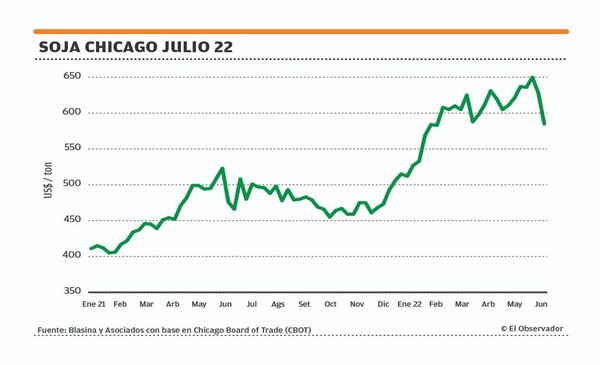Since the Federal Reserve in the United States (FED) determined a strong increase in rates with the prospect of continuing to rise, the commodity market around the world goes on the defensive.
In the case of grains, in addition the advance of the harvest of winter crops in the northern hemisphere adds a seasonal factor of great pressure that led to an overall fall.
Another component of the bearish equation is the outflow of palm oil from Indonesiawhich lifted the suspension it had imposed on exports.
Secondly, China’s demand for soybean meal has also fallen due to a weak situation and low prices for pigs.
The result is a very strong drop in the three main grains: soybeans, corn and wheat fell sharply this week, for the second consecutive.
Soybeans lost the reference of US$ 600 per ton and are trading above US$ 550about US$90 loss in the last 10 days.
The depreciation of the Brazilian currency also affects. A high dollar in Brazil encourages more soybean planting.
Fears about the heat wave in the United States have so far not materialized in damages and that context led to a strong outflow of funds that added pressure.
EO
The decline is also strong in wheat, where the harvest is advancing and thus the reference of US$400 per ton in Chicago has been lost, towards US$360 for the December position. which is a reference for barley for malting from Uruguay, which at US$325 has been equal to barley for export for the first time.
Wheat can still be sold at US$ 325 per ton for the next harvest and it is a reference that follows far below that of wheat in Chicago. In addition, the shortage of stocks in Uruguay ensures the firmness of the cereal.
Finally, rapeseed has also had a strong adjustment that takes it to US$ 615 per tonan attractive price, but much lower than it was at the time of sowing.

john samuel
Falling prices on Chicago blackboards.
Commercial uncertainty contrasts with the good production outlook. Planting was completed on the optimum date and the light rains this week consolidate an excellent start of the crops.
The summer harvest is almost finished, except for some fields of corn and sorghum and the winter crops planted with a record area and in record time, as if to compensate with volume for an uncertain commercial outlook.


















